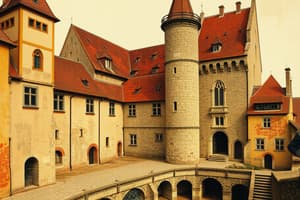Podcast
Questions and Answers
What was the purpose of Charlemagne setting up Christian schools?
What was the purpose of Charlemagne setting up Christian schools?
- To spread the influence of the Muslim armies
- To ensure the education of government officials (correct)
- To convert peasants to Christianity
- To provide education for the entire population
Who lived in the Manor House on a manor?
Who lived in the Manor House on a manor?
- The peasants and their families
- The lord and his family (correct)
- The knights and nobles
- The blacksmiths and bakers
What was the primary purpose of the large fields around the Manor?
What was the primary purpose of the large fields around the Manor?
- Peasant homes
- Noble residences
- Livestock, crops, and hunting (correct)
- Blacksmith workshops
What was the main feature of villages on a Manor?
What was the main feature of villages on a Manor?
Who were the only people allowed to hunt in the manor’s forests?
Who were the only people allowed to hunt in the manor’s forests?
What happened to the empire after Charlemagne's death?
What happened to the empire after Charlemagne's death?
What was the primary source of wealth for lords in a medieval manor?
What was the primary source of wealth for lords in a medieval manor?
What was the role of peasants on a medieval manor?
What was the role of peasants on a medieval manor?
Who were responsible for providing goods and services on a medieval manor?
Who were responsible for providing goods and services on a medieval manor?
What was the purpose of buildings such as mills, bake houses, and blacksmith shops on a medieval manor?
What was the purpose of buildings such as mills, bake houses, and blacksmith shops on a medieval manor?
What institution played an important role in the life of a medieval manor?
What institution played an important role in the life of a medieval manor?
Who was responsible for running the day-to-day operations of the manor under the lord's supervision?
Who was responsible for running the day-to-day operations of the manor under the lord's supervision?
What system of agriculture was commonly followed on medieval manors?
What system of agriculture was commonly followed on medieval manors?
What were some common challenges faced by people living on a medieval manor?
What were some common challenges faced by people living on a medieval manor?
Who was responsible for managing the financial affairs of a medieval manor?
Who was responsible for managing the financial affairs of a medieval manor?
Which figures contributed to the spread of Christianity and rise of feudalism in Western Europe during medieval times?
Which figures contributed to the spread of Christianity and rise of feudalism in Western Europe during medieval times?
During which period did a revival of learning and culture occur in the Middle Ages?
During which period did a revival of learning and culture occur in the Middle Ages?
What were peasants required to pay to the church and lord on a medieval manor?
What were peasants required to pay to the church and lord on a medieval manor?
What was the role of Missionaries sent by the Pope in Rome or the patriarch in Constantinople?
What was the role of Missionaries sent by the Pope in Rome or the patriarch in Constantinople?
What was the primary responsibility of Knights during feudalism?
What was the primary responsibility of Knights during feudalism?
What was the Concordat of Worms and how did it settle a conflict?
What was the Concordat of Worms and how did it settle a conflict?
What was the main feature of villages on a Manor during feudalism?
What was the main feature of villages on a Manor during feudalism?
What did Alfred the Great do in relation to Viking invasions?
What did Alfred the Great do in relation to Viking invasions?
What was the significance of William the Conqueror's action in 1066?
What was the significance of William the Conqueror's action in 1066?
What event led to King John being forced to sign the Magna Carta?
What event led to King John being forced to sign the Magna Carta?
Flashcards are hidden until you start studying
Study Notes
- Medieval manors were largely self-sufficient, with buildings devoted to special purposes such as mills, bake houses, and blacksmith shops.
- People living on a manor were peasants, tradespeople, women/children, or a higher class official.
- Peasants farmed and grew food for the manor to make money, while tradespeople provided goods and services.
- Women and children made clothes, prepared meals, or tended gardens and livestock.
- Lords were in charge of running the manor and giving out land, with wealth coming from collected rents, fines, and fees.
- Lords had assistants such as a bailiff and reeve to help manage the manor.
- Peasants worked from sunrise to sundown, with little freedom and paid taxes and tithes to the church and lord.
- Agriculture followed a three-field system, with crops planted and harvested seasonally.
- The church was an important institution in manor life, with Christianity common and people attending services and paying tithes.
- Peasants celebrated festivals and rest days from work.
- Hard times in manor life included famine, disease, and peasant rebellions.
- Manors were common in Western Europe, with figures such as Clovis, Charlemagne, and Pepin contributing to the spread of Christianity and the rise of feudalism.
- The Carolingian Renaissance saw a revival of learning and culture during the Middle Ages.
Studying That Suits You
Use AI to generate personalized quizzes and flashcards to suit your learning preferences.



